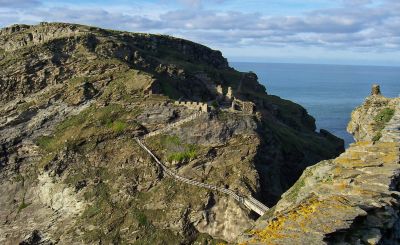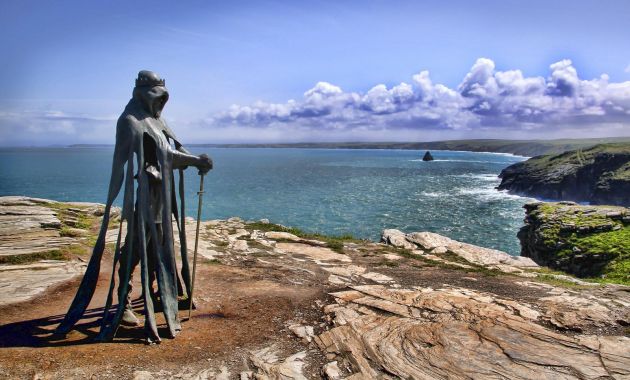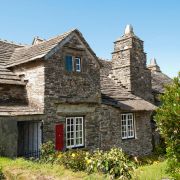
It is believed that Tintagel was an important trading post from late Roman times until the end of the 7th century. When Geoffrey of Monmouth wrote his history of King Arthur in the 12th century, the present Tintagel Castle would not have been there. So local legend may have been his only source of information about what had happened on this ancient headland stronghold. He tells that, towards the end of the Roman Occupation, the throne of Britain was offered to Constantine, who ruled for ten years and had three sons, one of whom was Uther. Although the children of Constantine were dispossessed, Uther Pendragon eventually reclaimed his rightful throne.
Tintagel was said to be the fortress of Gorlais, husband of the lovely Ygerna. The magician, Merlin, disguised Uther to look like Gorlais and tricked Ygerna into making love to him, resulting in the conception of King Arthur. Some scholars believe Tintagel was Camelot and other legends name the castle as one of King Mark’s strongholds, a place featuring in the tragic love story of Tristan and Isolde. There are certainly a number of legends indicating that there was a Cornish stronghold here, long before the construction of the Norman castle in the early 13th century.
The ruins of Tintagel castle today are those of the stronghold built around 1230 by Richard, Earl of Cornwall, son of the king. These ruins are now the property of the Duchy of Cornwall, successor to Earl Richard. The headland on which the ruins stand is surrounded by the sea on three sides and is sometimes described as an island. The remains of the 13th century castle are impressive, as much for their location as for the crumbling walls and steep stone steps.
It is believed that there may have been a castle built here by Earl Reginald around 1141. This Earl was the brother of Geoffrey of Monmouth’s patron, so maybe Tintagel was included in the history to win royal favour. However, most historians tend to believe that Geoffrey’s work predated the building of the earlier castle. Extensive excavations on Tintagel Island in the 1930s revealed Dark Age occupation there. More than twenty stone buildings were revealed along terraces on the eastern slopes of the promontory, and on the flat area around the Chapel of St Juliot.
A very large amount of 5th and 6th century Mediterranean pottery was found here, more than the total found in all other Dark Age sites in Britain. This included massive Tunisian oil jars, Carthaginian dishes, Aegean amphorae and Byzantine jars. The stone buildings have since been dated to the mediaeval period, but the chapel seems to have been rebuilt on earlier foundations.
In 1985 a survey of the whole area revealed contours of many more buildings buried beneath the landscape, across the wide plateau. Keyhole excavations on the eastern terraces indicate that earlier buildings exist on a lower level to those discovered in the 1930s, some of which may have been turf. Although there have been suggestions of an early monastic settlement here, the name Tintagel means “Fort of the Constriction”, indicating a military stronghold.
The large amount of expensive pottery found, which had been imported from the Eastern Mediterranean suggest that the stronghold was controlled by an important chief. So perhaps this was Gorlais, the Duke of Cornwall, or even King Mark… perhaps they both lived here at Tintagel in the Dark Ages.
Whatever the truth surrounding these legends, Tintagel was certainly a significant site, trading with merchants from Roman and the Mediterranean. It is impossible to tell if King Arthur was born here but archaeological evidence makes Tintagel a plausible site. It certainly appears to have been a royal citadel at the time at which Arthur is said to have reigned.
In 1998 a 6th century slab was uncovered at Tintagel, bearing the inscription “Pater coli avi fecit Artognov”, meaning “Artognou, father of a descendant of Coll, has had this built". The name, Artognou, was probably pronounced Arthnou. Apparently, Arth was a Dark Age prefix added to the name of a ruler. This merely confirms there was a wealthy person here in the 6th century with a name like Arthur. It does not prove King Arthur lived at Tintagel, but it was a rather tantalising find.
Naturally, Tintagel Castle today makes the most of the Arthurian connection. “Searching for King Arthur” is an audio visual tour introducing visitors to the castle, its history and, of course, the legends. During the summer there is also a special introductory talk at the Tintagel Castle Information Centre.
There is a newly refurbished shop on site and various other visitor facilities, including toilets. Across the road is a café. The castle is open every day throughout the year apart from 24 to 26 December and 1 January. It is situated on Tintagel Head, half a mile along an uneven track from the village. The nearest parking is in Tintagel village and there is a climb up at least 100 steep steps to reach the castle. Between April and September, a Land Rover service takes disabled people to the exhibition and shop. There is no need to book this service, unless it is for a large group.
Many of the surfaces are uneven and the site is a natural Cornish headland, including several cliffs. Due to the nature of the site, visually impaired visitors should have assistance. The walk from the church of St Materiana along the coastal footpath to Tintagel Castle is a lovely experience. The special path is suitable for wheelchairs alike and takes the visitor as far as the Inner Walls of the castle.
Nearby Castle Beach is a generally safe place to take a dip with Merlin’s Cave visible from the beach. All around the beach and castle is some of the most breathtaking scenery to be found anywhere.






